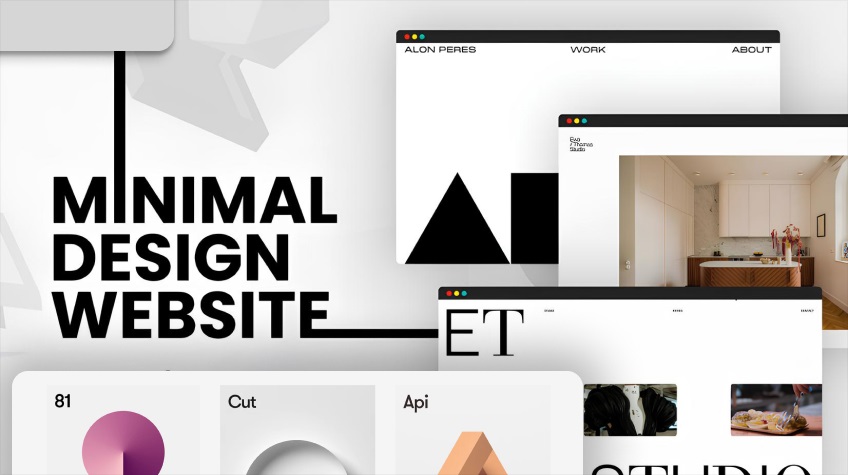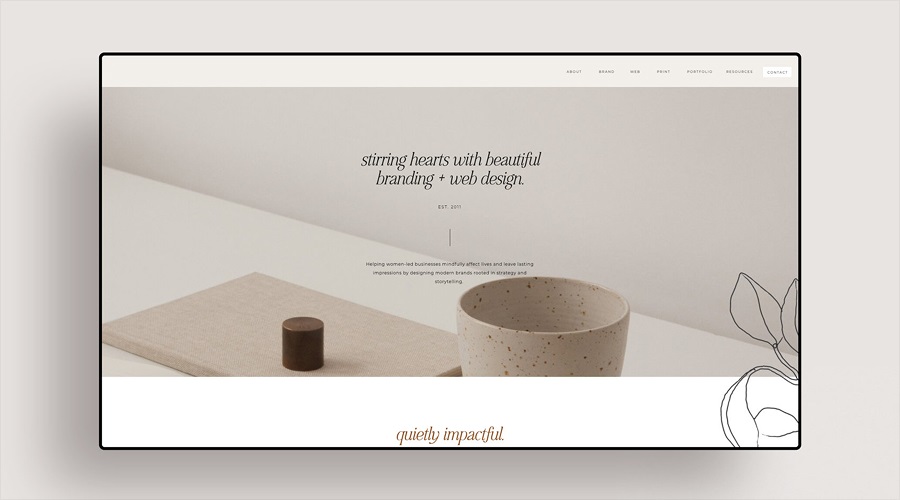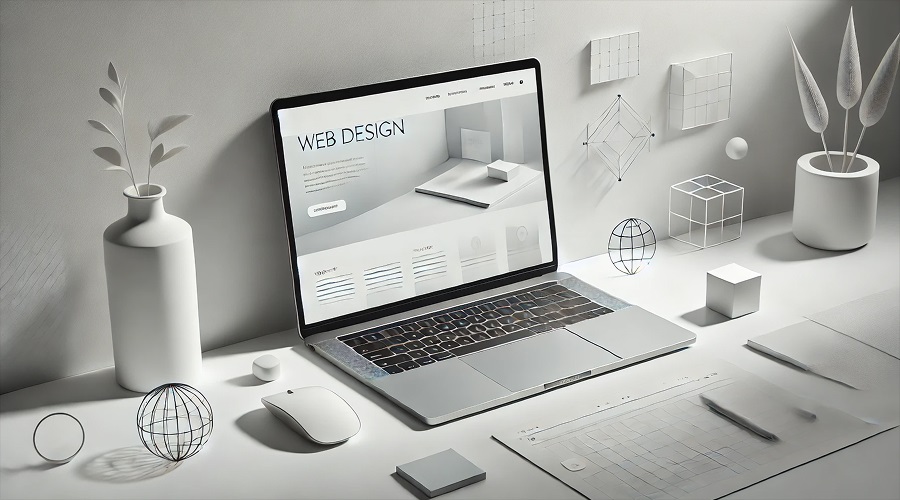
Minimalist web design is a clean and effortless design that is straightforward, non-confusing, and convenient. This blog explains the meaning of minimalist design, its essential principles, and the reasons why this style has become one of the most significant trends in the contemporary web development industry.
With digital overload and distractions everywhere, minimalistic web design is emerging. Its design style, cleanness of the layouts, high level of white space, and minimal elements on each page allow focus on things that matter to the users. Minimalism is not all about less is more. It is a concept of functional simplicity, where every single piece is fulfilling a definite purpose. Minimalist design is not a new thing in the field of art and architecture, but now it is taking the form of web design as well.
Minimalist websites have caught the attention not only of tech startups and creative portfolios but also because of their sleek, speedy, and easy-to-use qualities. Let’s understand the basics of what minimalist web design is, what the principles of this trend are, and why this trend is becoming increasingly popular.
What is Minimalist Web Design?

Minimalist web design is a style of design that removes unnecessary elements and goes with the basics. It is supposed to share information in a manner that is understandable, succinct, and appealing to the eye. A distraction-free experience is achieved through the use of a few colors, clear typography, clear navigation, and significantly vast amounts of white space by the designers.
The idea is to enhance practicality and emphasise significant data. They are simple or minimalist websites, instead of dazzling visitors with loads of graphics, complicated designs, or extravagant layouts. Each thing is selected with an intention.
Key Characteristics of Minimalist Design
The following are some of the typical characteristics of a minimalist website:
- Lots of white space: Gives a neat, breathable design that enhances easy reading.
- Simple typography: Heavy, hierarchical fonts that are easy to read.
- Limited color palette: Usually 2-3 colors, so that the design goes together.
- Flat or simple graphics: No redundant 3D effects, shades, and textures.
- Focused content: Pierced information that directs the user on what to do.
- Minimal distractions: Less use of animations, pop-ups, and banners to increase concentration.
All these features make a smooth experience, which is particularly crucial to mobile users.
Also Read: Web Design and Web Development: Its Key components and How Do They Work Together
Why is Minimalist Web Design Trending?

1. Mobile-First Design Needs Simplicity
Minimalist design is especially effective on mobile devices since it gets rid of clutter and helps maintain a clean layout. On the smaller screens, where there is less space, a simple design is easier to load, which also makes navigation easier. This will result in enhanced user experience and guarantee that your site will be nice to look at on any device.
2. Faster Page Load Speed
Minimalist websites feature fewer pictures, code, and styles, and this makes them faster. A faster loading site means better user satisfaction and a lowering of bounce rates. Search engines also rank based on speed, and therefore, a minimalist theme will enhance search optimization and performance on any browser and device.
3. Better User Experience (UX)
A simple design with no distractions will enable the users to search for what they want easily. The readable text, clear menus, and purposeful content will contribute to a more comfortable experience. Minimalism also assists by making websites easy to navigate and ensuring that the user is focused on the vital action.
4. Supports Brand Clarity
Minimalism allows your most important brand message to shine through without being hidden by excessive design elements. With fewer distractions, visitors can easily notice your logo, tagline, or key services. This boosts brand identity and helps present your business as professional and trustworthy, something any reputable web development company strives to deliver.
5. Timeless Aesthetics
Fashionable styles may become outdated soon, whereas minimalist design remains up-to-date. Websites with simplicity and grace have a contemporary and classic style. The brands, which rely on minimalism, do not need to redesign regularly, thus saving cost, energy, and providing a clean, stylish, and professional brand image that most users will be attracted to.
Principles Behind Minimalist Web Design
Here are some principles followed by designers to make a successful minimalist website:
- Purposeful Design: Each product must be justified. A button, image, and headline must add to the experience. Anything purposeless is thrown away.
- Visual Hierarchy: Design must lead to the important content. It is also a wise use of headings, body fonts, and spacing to make the information digestible
- Consistency: The uniformity of design, color, and font brings in stability. Users will be able to guess how things are done on your site; that is the ease you create trust and confidence.
- Content-First Approach: The design should facilitate the content rather than detract from it. The users need to be able to digest information within a short period and determine whether it is product information or blog articles.
- Emphasis on Functionality: Minimalist web design is all about its functionality. The navigation buttons, as well as the call-to-action buttons, should be easy and work well.
Benefits of Minimalist Web Design

1. Enhanced Readability
Minimalist design helps to make the content more readable with simple fonts, clear layout, and lots of white space. Readers are not overwhelmed, and visitors can grasp what you are telling them in no time. There are short paragraphs with clear headings, which make users go through the site without any difficulties, enhancing general cross-communication and having people spend more time and visit more pages.
2. Improved Conversion Rates
Having fewer distracting elements on a page allows the user to get to the point, such as clicking a button or completing a form. Minimalist websites are much more likely to draw attention to call-to-actions, generating better conversions. The concise structure guides the focus to the required areas, allowing the enterprises to facilitate more leads, registrations, and sales with minimal effort.
3. Easier Maintenance
The minimalist websites are easier to update and control. When there are fewer designs, there is not so much that can crack or fail. This implies faster edits, reduced maintenance rates, and fewer technical problems. The designers or developers are able to make changes more quickly, and the businesses can update content often at a reasonable cost.
4. Better SEO Performance
The benefits of minimalist web design result in quicker load time, mobile-friendliness, and easier code, all of which are much appreciated by the search engines. A simplistic structure will also make search bots crawl your site faster. Due to the increased usability and fewer technical clutter, minimalist websites will have a better chance of occupying the top positions in the search rankings and receiving more organic traffic.
6. Stronger Branding
With a clean and focused site, your message as a brand is overall more visible. Minimalist design allows you to emphasize your logo, colors, and significant messages without distracting your attention. This will then make your brand more professional and consistent, and will build trust with your visitors.
Popular Industries Using Minimalist Web Design
Various industries opt to use minimalism due to its cleanliness and direction:
- Technology: It is used to display products by start-ups and software companies.
- E-commerce: Orderly designs assist in emphasizing products and conversion.
- Creative Portfolios: It is used by designers and photographers in order to make their work shine.
- Health and Wellness: A relaxation, de-cluttered appearance suits the message of good health.
- Luxury Brands: Minimalism gives a luxurious touch to the experience.
Is Minimalism Right for Every Website?
Not necessarily. Minimalism is the way to go when you only have simple information, a clear message to pass, and your users care about ease of use rather than graphical show-offs. Sophisticated e-commerce or News websites may require additional functions and graphics that minimalism cannot provide.
However, a little bit of minimalism can work on most websites. At least taking out some of the clutter and streamlining your navigation can help immensely, even though you may not want to take things all the way.
Conclusion
Minimalist web design is not only a trend but also a careful strategy of creating user-friendly, ultra-fast, and beautiful websites. When users face an information overload, offering an uncluttered design is like providing relief. It optimizes the message of your brand, increases usability, and enhances device performance. Minimalist ideas can result in a superior online experience regardless of whether you are opening a new site or renovating an old one. Just keep in mind, simplicity does not restrict creativity, but enhances it.






